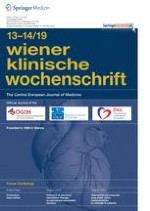29.04.2019 | original article
Incidence, etiology, predictors and outcomes of suspected drug hypersensitivity reactions in a tertiary care university hospital’s emergency department
A retrospective study
Erschienen in: Wiener klinische Wochenschrift | Ausgabe 13-14/2019
Einloggen, um Zugang zu erhaltenSummary
Background
Allergic drug reactions are adverse drug reactions that result from a specific immunologic response to a medication. Considering the epidemiological and clinical importance of drug allergy, this retrospective analysis focused on drug hypersensitivity in a tertiary care university hospital emergency department (ED).
Methods
In this study 74,929 ED records obtained from March 2012 to March 2015 were reviewed to determine the incidence, etiology, predictors and clinical features of drug hypersensitivity.
Results
The observed incidence of drug hypersensitivity was 0.87% of all ED admissions. It was significantly higher in female patients aged 18–29 years (2.26%; P < 0.0001) and during winter months (1.09%; P = 0.0058). Most patients had mild to moderate symptoms which regressed following ED treatment. Only five patients (7 per 100,000 ED visits) were diagnosed with drug-induced anaphylaxis, and only five patients were provisionally diagnosed with severe non-immediate reactions with systemic involvement. No patient died of drug hypersensitivity in the ED, and only a small proportion required subsequent hospitalization. The most common causes of drug hypersensitivity reactions were amoxicillin and paracetamol.
Conclusion
Drug hypersensitivity is a common reason for tertiary centre emergency admissions. This is the largest analysis of ED drug hypersensitivity admissions so far. Beta-lactams were identified as the leading cause of drug hypersensitivity requiring ED evaluation, which also explains the peak of drug hypersensitivity cases during winter months when the use of these medications is highest.
Anzeige
